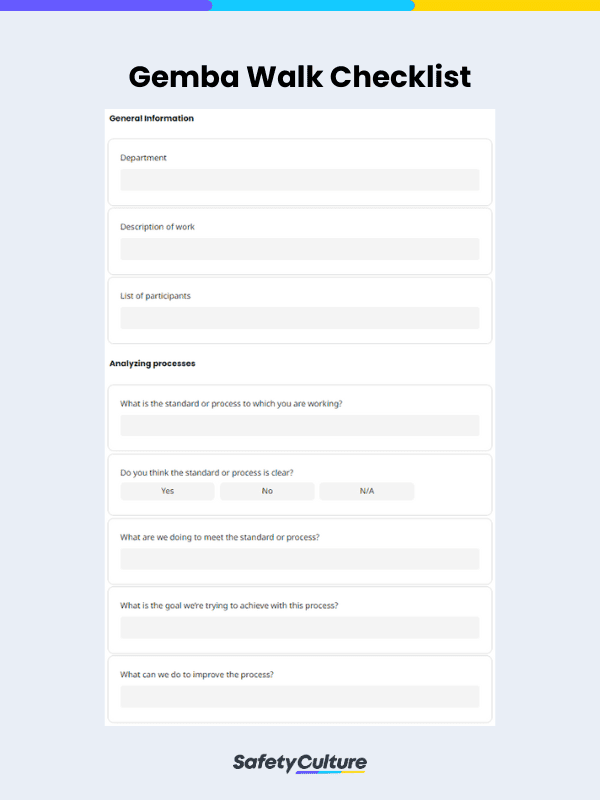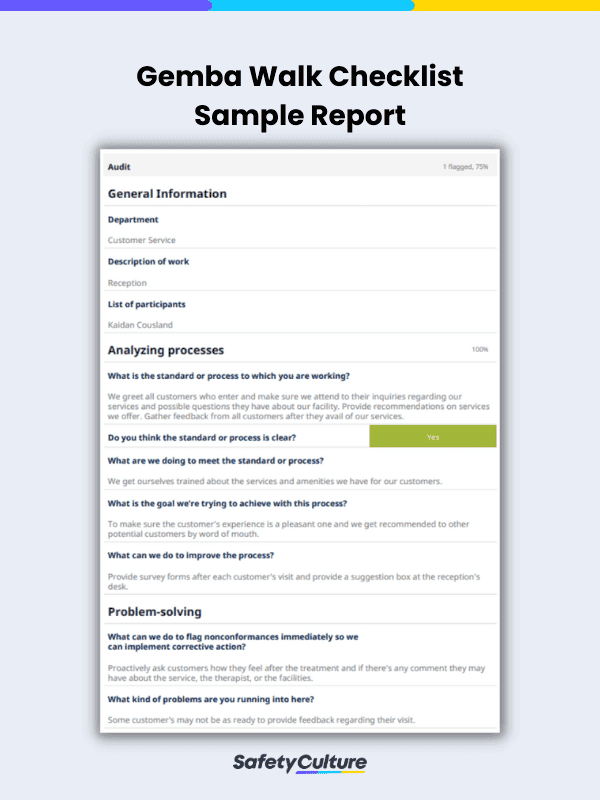What is a Gemba Walk Checklist?
A Gemba walk checklist is a tool used by management leaders to capture first-hand observations of what is exactly going on at the actual place where work happens. It lists items that one must check and assess during the process of a Gemba walk, helps document insights from discussions with employees, and serves as a reference tool on how to improve processes and reduce existing waste.
Importance of Using Checklists for Gemba Walks
Using checklists and templates plays a key role in the effectiveness and success of Gemba walks in an organization. Here are some top reasons why you should consider it:
- Focus and Structure – Gemba walk checklists help leaders and managers maintain focus on key areas of interest, ensuring that important aspects of the workplace are not overlooked.
- Consistency – The consistency of a Gemba walk checklist’s framework aids in making accurate comparisons and identifying patterns or trends across different observations.
- Standardized Benchmarking – Organizations can use a checklist to evaluate different areas or teams to identify gaps, share best practices, and drive overall improvement based on standardized criteria.
- Comprehensive Data Collection – Gemba walk checklists help leaders and managers capture diverse aspects such as safety, quality, workflow, and employee engagement.
- Documentation and Follow-up – The filled-out checklist can be a reference point for follow-up discussions, ensures that identified issues are not forgotten or overlooked, and aids in tracking progress and monitoring the effectiveness of improvement initiatives.
What to Include in a Gemba Walk Checklist
When creating a Gemba walk checklist, it’s important to tailor it to the specific needs and objectives of your organization. However, here are some important sections and questions you can consider including:
- General Information
- Department
- Description of Work
- Participants List
- Process Analysis
- Do you think the standard or process is clear?
- What are we doing to meet the standard or process?
- What is the goal we’re trying to achieve with this process?
- Problem-Solving
- What kind of problems are you running into here?
- Why is this a challenge?
- What have you done to determine the root cause?
- Tools and Resources
- Are our data and charts up-to-date?
- Do you have everything you need for this process?
- What would help break down barriers to solving problems?
- Continuous Improvement
- What is today’s priority and why?
- What do you intend to improve today?
- Are there any other questions you want to raise?
- Observations and Recommendations
In addition, remember to adapt the checklist based on your organization’s specific processes, industry, and goals. Involve employees in the checklist development process to ensure it captures their perspectives and needs. Regularly review and update the checklist to reflect changing circumstances and evolving improvement priorities.
How to Create and Use a Gemba Walk Checklist
Here’s a step-by-step guide on how you can create an effective checklist that can help you streamline your process of conducting Gemba walks:
- Determine the Objectives – Start by clarifying the objectives of your Gemba walks. What do you aim to achieve through these observations? Define the specific areas, processes, or issues you want to focus on during the walks to help you tailor the checklist accordingly.
- Involve Key Stakeholders – These include team leaders, supervisors, and frontline employees in the checklist creation process. Seek their input on the areas and items to include, so that different perspectives are considered.
- Identify Key Areas – These areas can be related to safety, workflow, quality, communication, and others specific to your organization. Break them down into specific items or questions to simplify the process.
- Prioritize and Organize – Based on their importance and relevance to your objectives, arrange key items in a logical order to ensure a systematic approach during the observations.
- Train Leaders and Managers – Provide training to those who will be conducting the Gemba walks to help them use the checklist effectively.
- Analyze Observations – Review the checklist findings and analyze the data collected to gain insights into patterns, trends, or recurring issues.
- Document Recommendations and Act on Findings – This will help create a solid action plan for your next steps to resolve recurring issues and prevent them from happening again.
SafetyCulture Marketplace: Your One-Stop Work Gear & Equipment Shop
During Gemba walks, one key area to check is if workers are equipped with the proper Personal Protective Equipment (PPE) and other safety gear. This way, the quality of their work isn’t the only thing taken into consideration; but also their safety in the workplace.
To further help you improve and sustain your safety initiatives, SafetyCulture Marketplace is here as your one-stop shop for all work gear and equipment needs. Get on-demand access to top quality and specialized work gear from trusted equipment brands in the industry—all in one centralized location. Raise the bar of safety and efficiency by empowering employees to request what they need with just a few taps, anytime and anywhere.
FAQs About Gemba Walk Checklists
Yes, Gemba walk checklists can be used in different industries. Here are a few examples of how they can be adapted to various use cases:
- Manufacturing – checking items related to equipment maintenance, production line efficiency, quality control processes, inventory management, and adherence to standard operating procedures
- Retail – focusing on visual merchandising, store cleanliness, inventory management, customer service interactions, pricing accuracy, and compliance with brand standards
- Hospitality – assessing guest satisfaction, cleanliness and maintenance of guest rooms and public areas, food and beverage quality, compliance with safety regulations, and staff training and engagement
Yes, since Gemba walks are an integral part of Lean methodologies, including Lean Six Sigma. Gemba walk checklists align with Lean Six Sigma principles in the following aspects:
- Reducing process waste like overproduction, defects, and excessive inventory
- Observing processes and value streams in real-time
- Collecting relevant data to support Lean Six Sigma’s emphasis on data-driven decision-making
- Identifying problems and areas of improvement
Yes, Gemba walk checklists can be used to track improvement progress in an organization. Here are some examples of how these checklists can help you:
- Baseline Assessment
- Quantitative Metrics
- Qualitative Observations
- Action Item Tracking
- Continuous Improvement Feedback
- Documentation and Reporting




